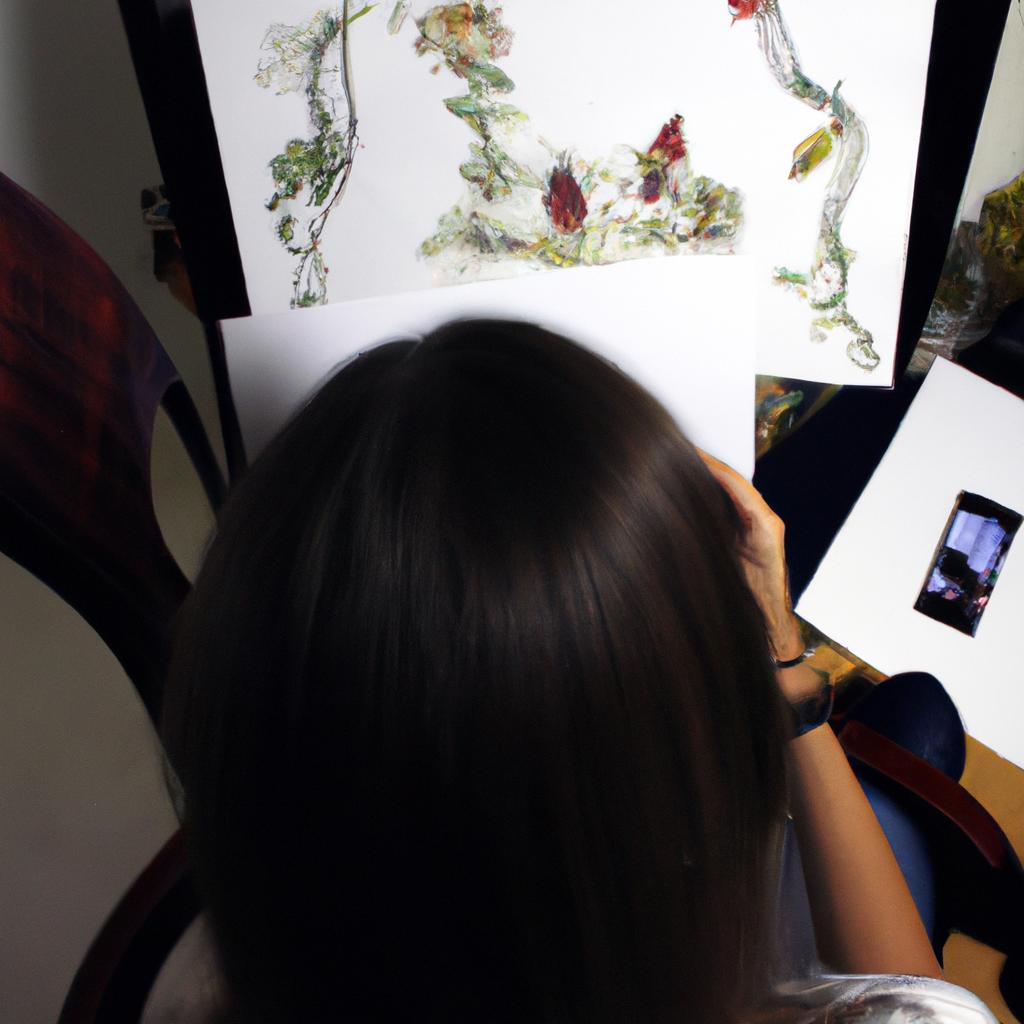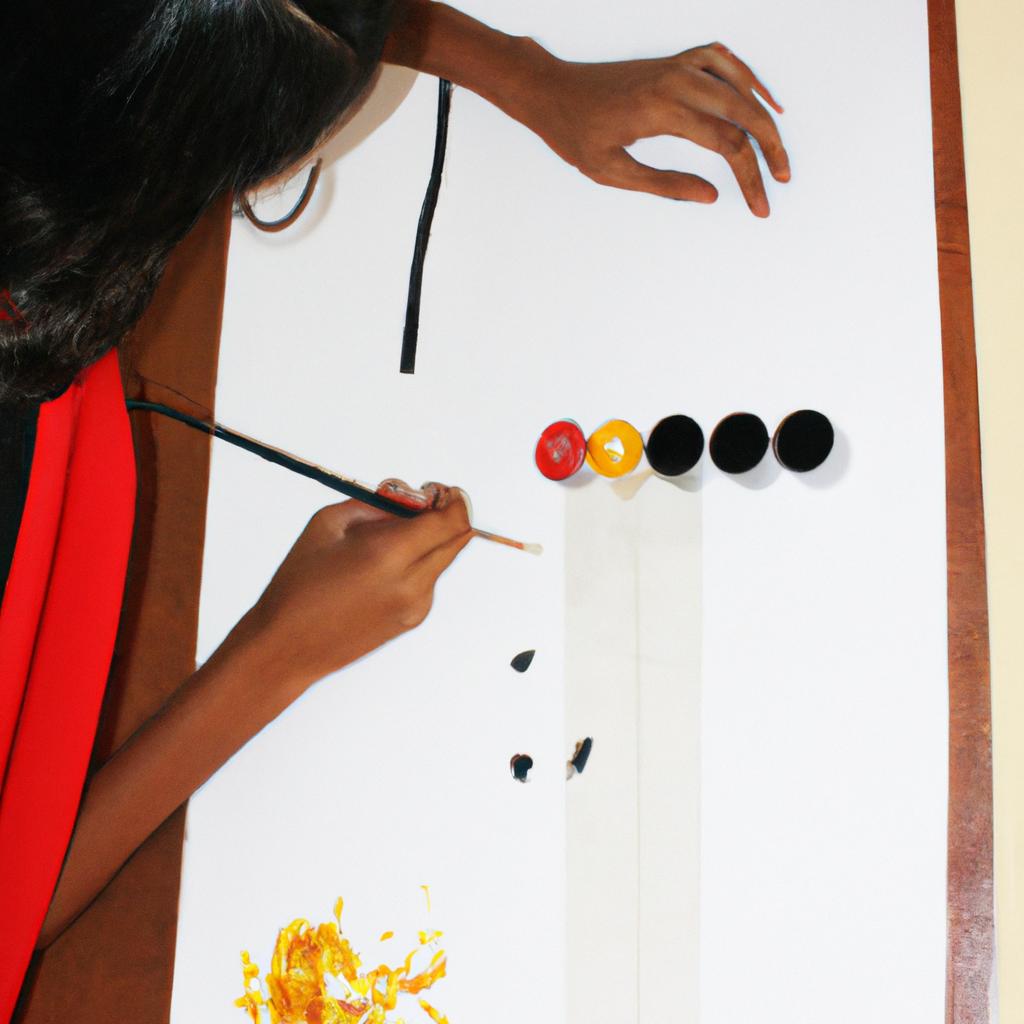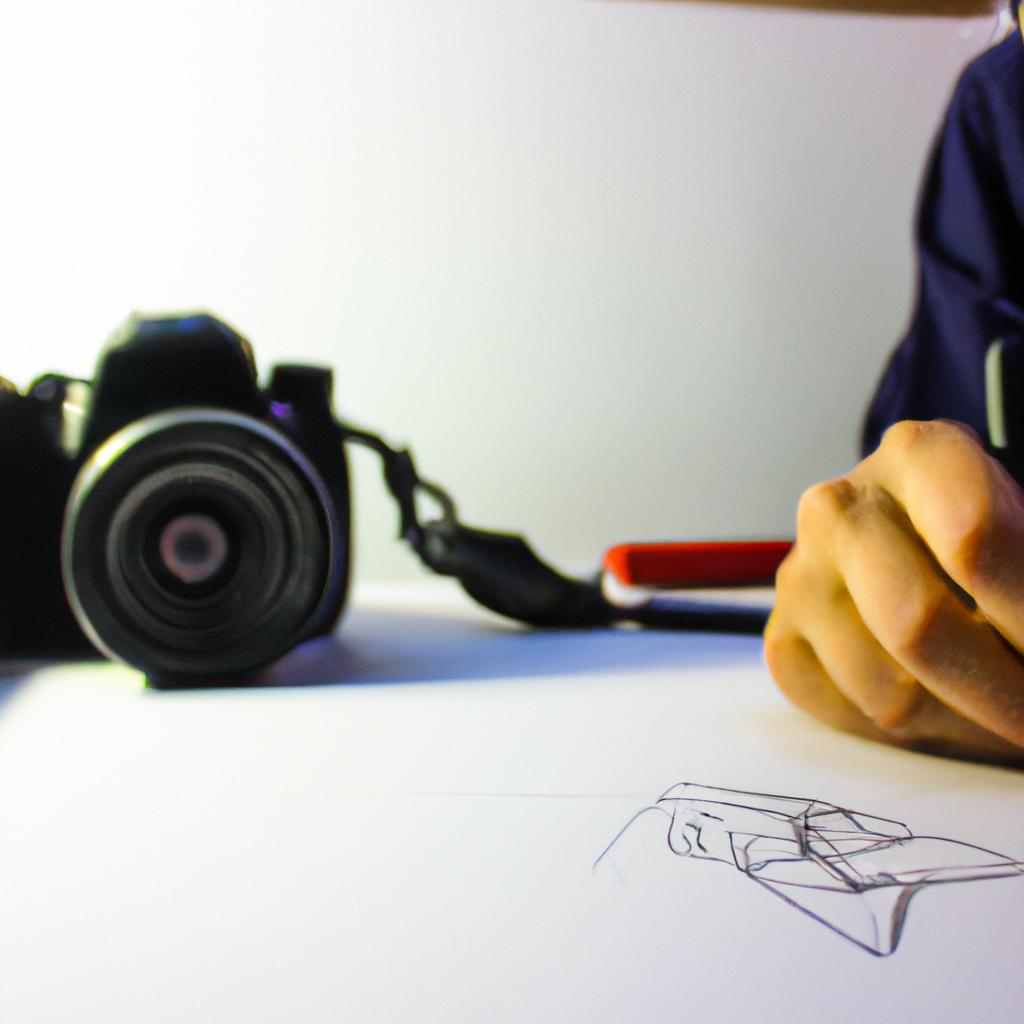Pencil drawing techniques have long been revered for their ability to capture intricate details and evoke a sense of artistic mastery in photography. This article explores the various methods and approaches utilized by skilled artists to create stunning pencil drawings that emulate the aesthetics of black and white photographs. By analyzing one hypothetical scenario, we can delve into the meticulous process involved in achieving such artistic excellence.
Imagine an artist tasked with creating a portrait using only pencils on paper. With each stroke of graphite, they carefully navigate the interplay between light and shadow to recreate the depth and texture found in traditional black and white photography. The artist takes advantage of various techniques such as hatching, cross-hatching, stippling, and blending to achieve remarkable levels of realism. Through deliberate mark-making, they are able to render minute details like wisps of hair or wrinkles on skin, resulting in a lifelike representation that could be easily mistaken for a photograph captured through a lens.
Understanding the Basics of Pencil Shading
To master the art of pencil shading, it is crucial to grasp the fundamental principles that underlie this technique. By understanding these basics, artists can create depth and dimension in their drawings, bringing their subjects to life on paper.
Let us consider an example: imagine you are drawing a still life composition consisting of various fruits placed on a tablecloth. Without proper shading techniques, your drawing may lack realism and appear flat. However, by employing effective pencil shading techniques, you can convey the texture of each fruit, creating a three-dimensional representation that captivates the viewer.
To achieve such results, there are several key aspects to keep in mind when engaging in pencil shading:
- Pressure: Varying pressure applied to the pencil while shading produces different tones and textures. Light pressure creates lighter shades, while heavy pressure generates darker ones.
- Stroke direction: The direction in which strokes are made affects how light interacts with the object being drawn. Consider using vertical or horizontal strokes for smoother surfaces and diagonal or curved strokes for rougher textures.
- Blending: Employing blending tools such as tissue paper or tortillons facilitates smooth transitions between shades, giving your drawings a polished look.
- Contrast: Utilizing a range of values from dark shadows to bright highlights enhances contrast and adds visual interest to your artwork.
Furthermore, implementing cross-hatching—a technique wherein layers of parallel lines intersect—offers additional opportunities for creating depth and dimension in your drawings.
By understanding these basic principles of pencil shading and incorporating them into your artistic practice, you will be well-equipped to bring ordinary objects to life through realistic rendering. In the following section about “Creating Depth and Dimension with Cross-Hatching,” we will explore how this technique further builds upon these foundational skills without losing sight of the overall objective—to produce captivating works of art through mastery of pencil drawing techniques.
Creating Depth and Dimension with Cross-Hatching
Section Title: Mastering Realism with Pencil Drawing Techniques
Having gained a solid understanding of the basics of pencil shading, we can now delve into more advanced techniques that will elevate your artwork to new heights. By incorporating cross-hatching into your drawings, you can create depth and dimension, making your subjects come alive on paper.
Creating Depth and Dimension with Cross-Hatching:
To illustrate the power of cross-hatching, let’s consider a hypothetical scenario where an artist aims to depict a ball resting on a table. Using only basic shading techniques would result in a flat representation lacking in visual interest. However, by employing cross-hatching, the artist can effectively convey form and volume. By using parallel lines intersected by additional layers at different angles, shadows are intensified and contours are defined. This technique enables artists to capture light and shadow realistically, resulting in a three-dimensional appearance.
Incorporating Emotion through Technique:
- Precision: The deliberate placement of each line showcases the artist’s meticulous attention to detail.
- Intensity: Gradually building up dense areas of hatched lines conveys dramatic contrasts between light and dark.
- Complexity: Skillfully executed cross-hatching adds complexity and richness to the drawing.
- Mastery: A masterful employment of this technique evokes awe-inspiring realism that captivates viewers.
Table: Effects Achieved through Cross-Hatching
| Effect | Description |
|---|---|
| Volume | Creates the illusion of solidity and weight |
| Texture | Depicts surface characteristics such as smoothness or roughness |
| Form | Defines the shape or structure of objects |
| Contrast | Enhances highlights and shadows for greater visual impact |
By embracing cross-hatching as part of your artistic repertoire, you unlock endless possibilities for capturing depth within your work. As you explore further into these techniques, remember that practice and patience are key. The ability to create lifelike representations through cross-hatching requires time and dedication, but the results will undoubtedly be worth it.
Now that we have covered the fundamentals of creating depth with cross-hatching, let us move on to exploring texture through stippling as another powerful tool in your artistic arsenal.
Exploring Texture through Stippling
Exploring different techniques in pencil drawing allows artists to unlock new dimensions of creativity and artistic expression. In this section, we will delve into the captivating world of stippling, a method that involves creating texture and depth using small dots or marks. By incorporating stippling into your artwork, you can add intricate details and visual interest to your drawings.
Imagine for a moment an artist meticulously working on a portrait, carefully applying tiny dots with their pencil to capture every nuance of the subject’s face. Through the painstaking process of stippling, the artist brings forth subtle shadows and highlights, giving life to their creation. This technique requires patience and precision but rewards the artist with stunning results.
To effectively employ stippling in your own work, consider the following:
- Varying dot sizes: Experiment with different pen or pencil tip sizes to create varying effects within your piece.
- Density control: Adjust the spacing between each dot to control the overall tone and value of specific areas in your drawing.
- Layering: Build up layers of dots to achieve deeper shadows or gradual gradients in certain parts of your artwork.
- Contrast manipulation: Play with contrast by juxtaposing heavily stippled areas against more sparsely dotted sections.
Incorporating these techniques unlocks endless possibilities for experimentation and creative exploration. As you become familiar with stippling, you will develop a unique style that sets your artwork apart from others. The next section will continue our journey into mastering various techniques by exploring how blending and smudging can enhance the realism and impact of your pencil drawings without losing sight of individuality.
Mastering the Art of Blending and Smudging
In the previous section, we delved into the mesmerizing effect of stippling as a technique to convey texture in pencil drawings. Now, let us explore another essential skill that contributes to artistic mastery – blending and smudging.
Imagine you’ve just completed a remarkable portrait using stippling techniques, but you feel there’s something missing. The skin lacks depth and softness, leaving your subject looking flat on paper. This is where blending and smudging come into play. By carefully manipulating graphite or charcoal with your fingers, a stump, or tortillon, you can create smooth transitions between tones and add dimensionality to your artwork.
To effectively master blending and smudging techniques, consider the following key points:
- Start by selecting the appropriate tools for blending and smudging; cotton swabs, chamois leather, or even tissue paper can all be effective.
- Experiment with different pressure levels while blending – lighter pressure creates softer transitions while heavier pressure produces bolder effects.
- Be mindful of avoiding over-blending; it may result in loss of detail or muddy tonal values.
- Practice on scrap paper before applying these techniques to your main drawing to familiarize yourself with their impact.
By utilizing blending and smudging alongside other shading methods like hatching and cross-hatching (as explored in subsequent sections), an artist has a diverse range of tools at their disposal to achieve various textures within their work.
| Blending & Smudging Tips |
|---|
| ✓ Choose appropriate tools |
| ✓ Vary pressure levels for desired effects |
| ✓ Exercise caution to avoid over-blending |
| ✓ Practice beforehand |
Taking advantage of these technical skills will allow artists to depict various subjects more realistically while providing additional visual interest through textural variations. In our next section, we will delve into “Capturing Realism with Hatching and Cross-Hatching” — a fundamental technique in achieving lifelike pencil drawings.
Capturing Realism with Hatching and Cross-Hatching
In the previous section, we explored the art of blending and smudging to achieve seamless transitions in pencil drawings. Now, let us delve into another fundamental technique that adds depth and dimension to your artwork: shading. By mastering various shading techniques, you can create realistic shadows and highlights, bringing your subjects to life on paper.
Imagine drawing a still-life composition featuring an apple resting on a table. To capture its three-dimensional form convincingly, shading plays a vital role. One effective shading technique is known as chiaroscuro – the use of strong contrasts between light and dark areas. By carefully observing how light falls on objects, you can depict their volume realistically. For instance, by applying heavier shading on one side of the apple where it’s less illuminated, you can effectively convey its rounded shape.
To further enhance your understanding of shading techniques, consider these key points:
- Contrast: Utilize varying degrees of darkness and lightness to emphasize different elements within your drawing.
- Gradation: Create smooth transitions from dark to light or vice versa by gradually adjusting the pressure applied with your pencil.
- Cross-contour lines: Use parallel lines that follow the contours of the subject to suggest its three-dimensionality.
- Hatching and cross-hatching: Employ these methods to add texture and value variation in specific areas for more intricate details.
By incorporating these principles into your work, you will be able to masterfully render depth and dimension in your pencil drawings. Consider this hypothetical case study showcasing different approaches to shading techniques:
| Technique | Application | Result |
|---|---|---|
| Chiaroscuro | A portrait drawing using contrasting tones creates dramatic lighting effects. | Realistic portrayal with striking visual impact |
| Gradation | Shading a landscape scene allows for smooth transitions from foreground to background elements. | Enhanced sense of distance within the artwork |
| Cross-contour lines | Drawing a still-life composition of a textured object, such as tree bark, utilizing cross-contour lines enhances the perceived volume and texture. | Increased tactile quality in the drawing |
| Hatching and cross-hatching | Applying these techniques to depict fabric folds in a clothing illustration adds depth and visual interest. | Detailed representation with added texture |
As you explore shading techniques, remember that mastering them requires practice, patience, and careful observation. By continually experimenting with different approaches, you will discover your unique style while honing your skills.
Transition into subsequent section: ‘Enhancing Composition with Light and Shadow’
With an understanding of how shading can bring depth and dimension to your drawings, we can now delve into the next aspect of enhancing your artwork – exploring the interplay between light and shadow.
Enhancing Composition with Light and Shadow
Building upon the techniques of hatching and cross-hatching, artists can further enhance their pencil drawings by incorporating texture and depth. By exploring these elements, artists can elevate their compositions to new levels of creativity and visual interest.
In this next section, we will delve into how texture and depth can be effectively utilized in pencil drawings. Let us consider an example: imagine a landscape drawing depicting a serene forest scene. Through skillful use of texture and depth, the artist brings the viewer closer to experiencing the tranquility and beauty of nature. The careful rendering of tree bark through various shading techniques creates a tactile illusion that invites viewers to touch the paper, while the depiction of foliage using different stroke patterns adds dimensionality to the artwork.
To achieve compelling results when employing texture and depth in pencil drawings, artists should keep certain key factors in mind:
- Variation in line weight: By varying the pressure applied on the pencil, artists can create lines with differing widths, resulting in a more dynamic representation of textures.
- Layering techniques: Gradually building up layers of graphite allows for greater control over value transitions, enabling artists to represent smooth surfaces or rough textures convincingly.
- Experimentation with mark-making tools: Beyond traditional pencils, other implements such as charcoal sticks or tortillons can add unique textures to artworks.
- Exploration of mixed media possibilities: Combining pencil with other mediums like ink or pastels offers endless opportunities for creating intriguing juxtapositions between smoothness and roughness.
Table – Emotional response evoking examples:
| Emotion | Example |
|---|---|
| Serenity | A tranquil beachscape where gentle strokes mimic lapping waves |
| Intrigue | An enigmatic portrait featuring intricate details hidden within shadows |
| Wonder | A whimsical fantasy world brought to life through imaginative textures |
| Nostalgia | A nostalgic still life evoking memories through carefully rendered textures |
Incorporating texture and depth into pencil drawings expands the creative potential of artists, allowing them to convey a range of emotions and captivate viewers. By skillfully manipulating line weight, layering techniques, mark-making tools, and exploring mixed media possibilities, artists can imbue their artworks with a palpable sense of serenity, intrigue, wonder, or nostalgia. The interplay between these elements invites viewers to embark on an emotional journey through the artist’s vision, making each drawing a unique experience for all who encounter it.
 Balazo Gallery
Balazo Gallery



